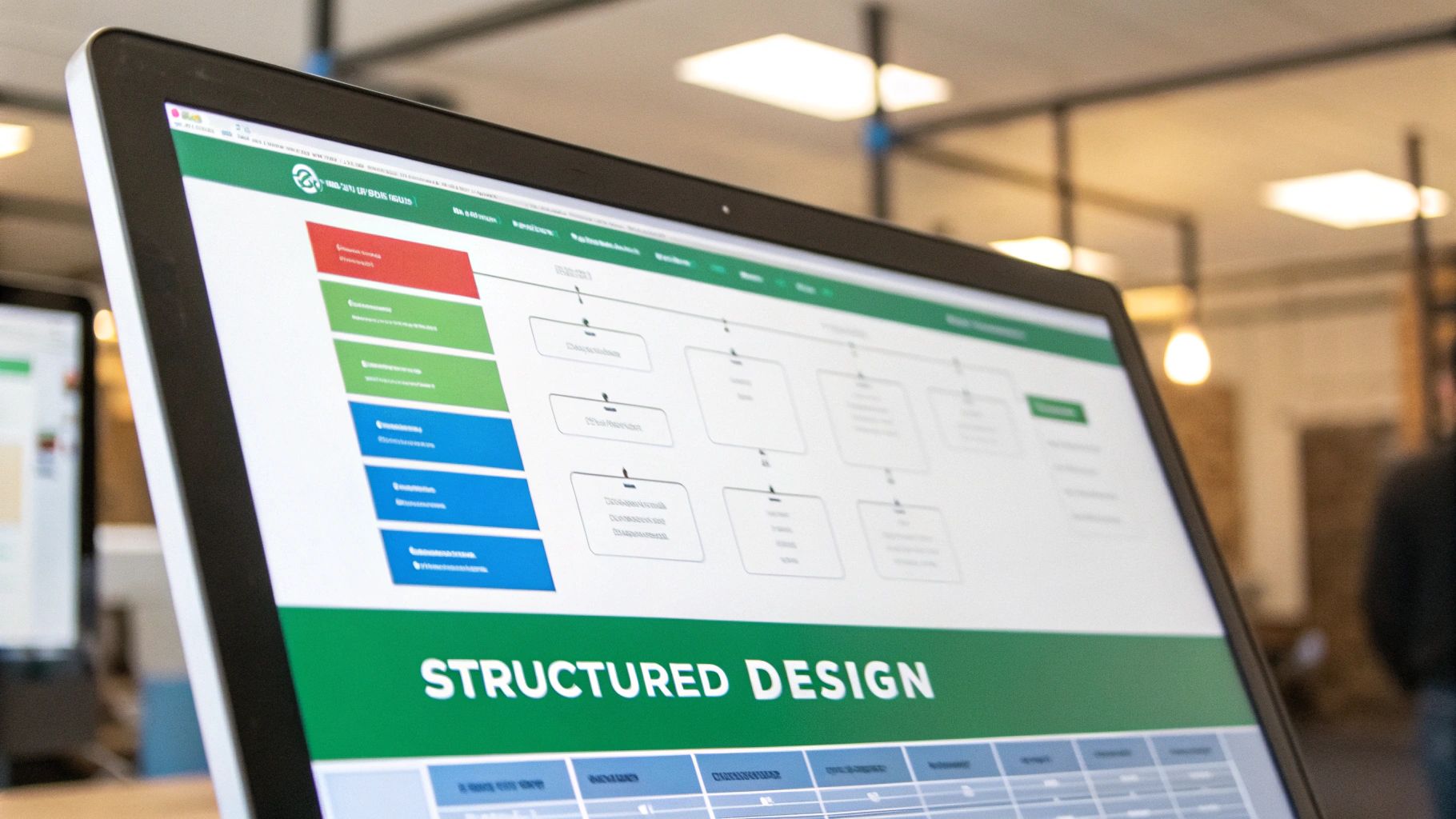Discover the essential skills of technical writing and learn 8 key techniques to produce clear, effective documentation.
Effective technical documentation is crucial for product success. This listicle provides eight essential skills to enhance your technical writing, whether you’re creating API documentation, user manuals, or training materials. Mastering these skills will improve content clarity, usability, and overall effectiveness, ultimately benefiting your users and your product. We’ll cover clear writing, audience analysis, document design, technical knowledge, research skills, visual communication, version control, and quality assurance. These core competencies are essential for any individual or team producing technical content.
Clear and concise writing is the cornerstone of effective technical communication. It’s the ability to convey complex technical information in a straightforward and easily digestible manner. This involves meticulous attention to language, ensuring precision while avoiding jargon and unnecessary complexity. Information is structured logically, allowing readers to quickly grasp the core concepts and instructions without wading through dense prose. For technical audiences, this accelerates their workflow; for non-technical audiences, it makes the material accessible and understandable.

This skill is paramount in a technical context because it directly impacts the usability and effectiveness of documentation, instructions, and any other form of technical communication. Misunderstandings stemming from poorly written documentation can lead to errors in implementation, delays in project timelines, and increased frustration for all involved. Clear writing minimizes ambiguity, ensuring that everyone is on the same page.
Features of Clear and Concise Writing:
Precision in Language Use: Choosing words that have a singular, unambiguous meaning within the technical context.
Elimination of Redundancy and Verbosity: Removing unnecessary words and phrases that don’t add value to the communication.
Use of Active Voice over Passive Voice: Constructing sentences where the subject performs the action, leading to more direct and impactful communication.
Appropriate Word Choice for Technical Concepts: Balancing the use of technical terms with simpler explanations to cater to a potentially mixed audience. Pros:
Improved Readability and Comprehension: Readers can easily understand the information presented.
Reduces Confusion and Misinterpretation: Minimizes ambiguity and ensures clarity of meaning.
Makes Documents More Accessible to Non-Technical Audiences: Bridges the gap between technical experts and those with less technical knowledge.
Saves Readers’ Time: Allows readers to quickly extract the information they need. Cons:
Can be Challenging When Explaining Complex Technical Concepts: Simplifying without sacrificing accuracy requires skill and effort.
May Require Multiple Revisions to Achieve Optimal Clarity: Writing concisely often involves iterative refinement.
Finding the Balance between Simplicity and Technical Accuracy Can Be Difficult: Oversimplification can lead to inaccuracies, while excessive technical detail can overwhelm readers. Examples of Successful Implementation:
Apple’s product documentation: Renowned for its clean, straightforward language and user-friendly approach.
Microsoft Style Guide: Explicitly emphasizes concise writing and provides practical guidance for achieving it.
Google’s technical documentation: Successfully balances in-depth technical information with clear and accessible explanations. Actionable Tips for Clear and Concise Writing:
Use one idea per sentence: This enhances clarity and prevents sentences from becoming convoluted.
Replace complex words with simpler alternatives when possible: Choose words that your target audience can easily understand.
Read your writing aloud to identify unclear or convoluted sections: This helps you catch awkward phrasing and identify areas that need improvement.
Use bullet points and numbered lists for sequential instructions: This breaks down complex processes into manageable steps.
Eliminate filler words and phrases (e.g., ‘basically’, ‘in order to’): These words often add clutter without contributing to the meaning. When and Why to Use This Approach:
Clear and concise writing is crucial for any form of technical communication, including:
Audience analysis is the cornerstone of effective technical writing. It involves systematically identifying and understanding the target audience’s needs, knowledge level, expectations, and preferences. This process enables writers to tailor content precisely, ensuring it provides the right level of detail and explanation. Without a thorough understanding of the audience, even technically accurate documentation can be ineffective and frustrating for users. This translates to wasted time, increased support requests, and ultimately, a less successful product.

Audience analysis operates on several key features: identifying primary and secondary audiences, understanding their technical expertise levels, recognizing cultural and linguistic nuances, and assessing their specific goals and information needs. For instance, documentation for a software library might have both software developers (primary audience) and DevOps engineers (secondary audience) as target users. Developers need detailed API references, while DevOps engineers might prioritize integration and deployment instructions. Understanding these distinct needs allows writers to structure and present information accordingly.
Examples of successful audience analysis in technical documentation abound. Arduino’s documentation effectively caters to both beginners and experienced users by providing introductory tutorials alongside in-depth technical specifications. Salesforce employs a tiered documentation approach (beginner, intermediate, advanced) to address varying user proficiency levels. AWS technical documentation offers different paths for various user roles, ensuring developers, system administrators, and business users can easily find relevant information.
Why Use Audience Analysis?
This approach is crucial for maximizing the usability and effectiveness of technical documentation. It deserves a prominent place in any technical writer’s skillset because it directly impacts user satisfaction and product adoption.
Pros:
Creates more relevant and usable documentation: Content tailored to the audience’s needs is easier to understand and apply.
Reduces support requests and user frustration: Clear and targeted documentation empowers users to solve problems independently.
Increases user satisfaction and product adoption: Positive user experiences lead to higher satisfaction and increased product uptake.
Improves efficiency by focusing on what users actually need: By prioritizing relevant information, writers avoid creating unnecessary content, saving time and resources. Cons:
May require extensive research and feedback collection: Understanding the audience can be time-consuming, especially for complex products with diverse user bases.
Writing for multiple audience types simultaneously can be challenging: Balancing the needs of different user groups requires careful planning and execution.
Audience needs may change over time, requiring document updates: Ongoing maintenance and updates are necessary to keep documentation relevant and accurate. Actionable Tips for Implementing Audience Analysis:
Create user personas: Develop representative profiles of different audience segments to understand their characteristics and needs.
Conduct interviews or surveys with actual users: Gather direct feedback from target users to validate assumptions and identify specific information needs.
Test documentation with sample audience members: Usability testing reveals how well the documentation meets the needs of real users.
Include glossaries for less technical audiences: Define technical terms to ensure accessibility for all users.
Provide progressive disclosure: Present basic information first, with options to explore advanced topics for those who require more detail. Popularized by influential figures in technical communication like Karen Schriver and JoAnn Hackos, and further refined by user experience (UX) research methodologies, audience analysis remains a crucial element of effective technical writing. By adopting a user-centered approach, technical writers can create documentation that truly empowers users and contributes to product success.
Document Design and Information Architecture is the cornerstone of effective technical writing. It focuses on structuring and presenting content in a way that maximizes usability, accessibility, and comprehension. This involves strategically organizing information into a logical hierarchy, leveraging visual elements effectively, and establishing consistent patterns that allow users to navigate and locate information effortlessly. This skill goes beyond simply writing clear sentences; it’s about crafting an entire user experience around the information itself. For software developers, engineers, tech startups, and anyone creating technical documentation, mastering this skill is crucial for ensuring that your documentation is not just readable, but truly usable.

Key features of effective document design and information architecture include the strategic use of headings and subheadings to create a clear visual hierarchy, the development of intuitive navigational structures (such as tables of contents, indexes, and cross-references), consistent formatting and the use of templates to maintain uniformity, and the integration of visual elements like diagrams, tables, and charts to illustrate complex concepts. Employing white space judiciously also greatly improves readability and reduces visual clutter.
Well-designed documentation significantly improves the scanability and findability of information. By presenting information in a structured and predictable manner, it reduces the cognitive load on readers, allowing them to quickly grasp key concepts and locate specific details. This enhances the overall user experience and makes even complex information more digestible. Examples of successful implementations include Atlassian’s product documentation, known for its clear navigation and chunking of information; GitHub’s documentation, which maintains a consistent structure across a vast range of topics; and Red Hat’s documentation, lauded for its robust information architecture. Learn more about Document Design and Information Architecture to delve deeper into these principles.
While the benefits are undeniable, implementing effective document design and information architecture requires careful consideration. Balancing aesthetics with functional needs can be challenging, and specialized knowledge of design principles may be necessary. The process can also be time-consuming, especially for large documentation projects. However, the long-term benefits in terms of user satisfaction and reduced support costs far outweigh the initial investment.
To enhance your technical documentation through effective document design, consider these actionable tips:
Technical Subject Matter Knowledge is a cornerstone of effective technical writing. It refers to the writer’s ability to grasp and articulate complex technical concepts, systems, or processes accurately. This skill goes beyond simply understanding the terminology; it involves developing sufficient domain expertise to comprehend the underlying principles and practical applications of the subject matter. This deep understanding allows technical writers to create documentation that is not just grammatically correct, but also technically sound, relevant, and valuable to the target audience.
How it Works:
Developing technical subject matter knowledge is an iterative process. It begins with foundational research and learning about the specific domain. This might involve studying existing documentation, taking online courses, or attending workshops. The next stage involves practical application and hands-on experience with the technology. This could include using the software, experimenting with the hardware, or participating in development projects. Finally, continuous learning and staying up-to-date with the latest advancements in the field are crucial for maintaining expertise.
Features and Benefits:
Deep understanding of technical domains and terminology: Allows the writer to use precise language and avoid ambiguities.
Ability to research and learn new technical concepts quickly: Enables adaptation to rapidly evolving technologies.
Capability to translate technical knowledge into accessible explanations: Makes complex information understandable for various audiences.
Understanding of technical workflows and use cases: Ensures the documentation is practical and relevant to real-world scenarios. Pros:
Ensures accuracy and credibility of documentation: Builds trust with users and stakeholders.
Reduces the need for extensive SME (Subject Matter Expert) review: Saves time and resources.
Enables creation of more practical and useful documentation: Increases user satisfaction and product adoption.
Facilitates better collaboration with development teams: Improves communication and reduces misunderstandings. Cons:
Typically requires ongoing learning and professional development: Demands continuous investment of time and effort.
Technology changes rapidly, requiring continuous knowledge updates: Staying current can be challenging.
Difficult to maintain expertise across multiple technical domains: Specialization may be necessary. Examples of Successful Implementation:
API documentation experts who understand programming concepts: They can accurately describe API functionalities, parameters, and return values, enabling developers to integrate the API effectively.
Technical writers at NASA who document aerospace engineering processes: Their deep understanding of aerospace principles ensures the accuracy and reliability of critical documentation.
Medical device documentation specialists with knowledge of healthcare regulations: Their expertise ensures compliance and patient safety. Actionable Tips:
Allocate time for hands-on experience with the technology being documented: “Learning by doing” is invaluable for gaining practical knowledge.
Develop relationships with subject matter experts (SMEs): SMEs can provide valuable insights and answer specific questions.
Take courses related to your technical domain: Formal education can provide a strong foundation.
Join professional communities related to your technical field: Networking and knowledge sharing are crucial for staying current.